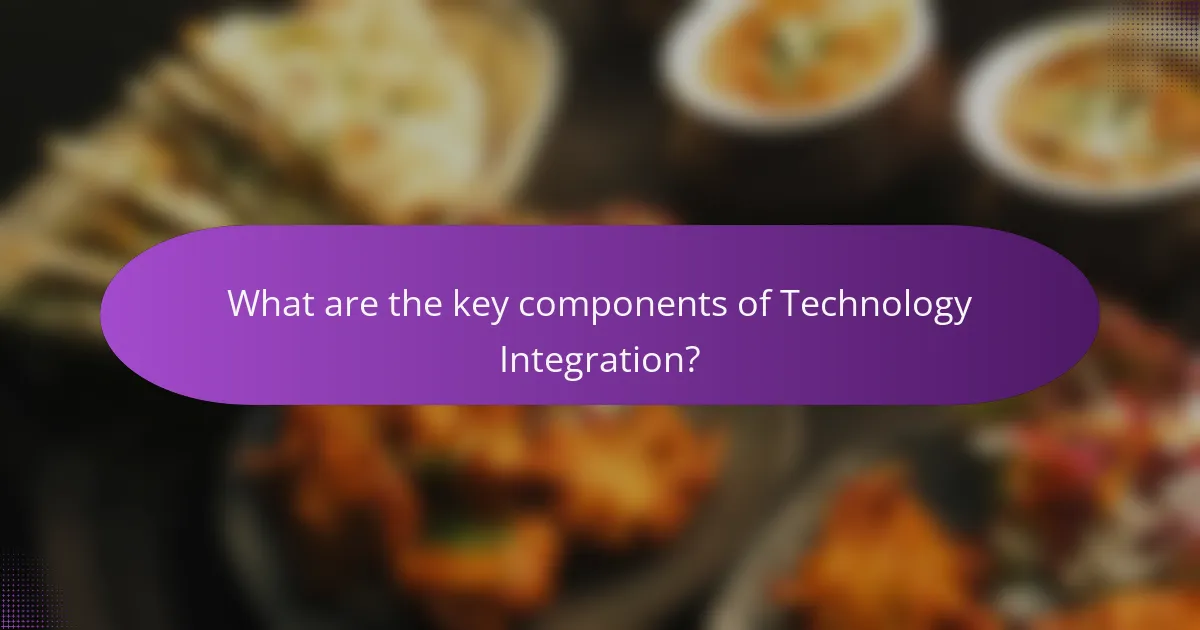
What is Technology Integration in Canadian Italian Restaurants?
Technology integration in Canadian Italian restaurants refers to the implementation of digital tools and systems to enhance operational efficiency and customer experience. This includes the use of point-of-sale systems, online reservation platforms, and mobile ordering applications. These technologies streamline processes such as order management and payment processing. Additionally, they facilitate better communication between staff and customers. Research indicates that restaurants utilizing technology integration see improved service speed and customer satisfaction. For example, a study by the National Restaurant Association highlights that 70% of diners prefer restaurants offering digital ordering options. This integration ultimately leads to increased sales and operational productivity in the competitive restaurant industry.
How does Technology Integration enhance service efficiency?
Technology integration enhances service efficiency by streamlining operations and improving communication. It automates routine tasks, reducing manual errors. For example, point-of-sale systems speed up transaction processing. This allows staff to focus on customer service. Additionally, integrated inventory management systems track stock levels in real-time. This minimizes waste and ensures timely restocking. A study by McKinsey found that digital tools can improve productivity by up to 20%. Overall, technology integration leads to faster service and better resource management.
What specific technologies are commonly integrated in these restaurants?
Common technologies integrated in Canadian Italian restaurants include point of sale (POS) systems, online ordering platforms, and kitchen display systems. POS systems streamline transactions and manage inventory effectively. Online ordering platforms enhance customer convenience and expand reach. Kitchen display systems improve communication between front-of-house and kitchen staff. Additionally, mobile payment solutions facilitate quick and secure payments. These technologies collectively enhance service efficiency and customer experience in the restaurant industry.
How do these technologies improve customer experience?
Technologies improve customer experience by streamlining service and personalizing interactions. Automated ordering systems reduce wait times for customers. Mobile payment options enhance convenience and speed during transactions. Customer relationship management tools help businesses understand preferences and tailor offers. Real-time feedback systems allow immediate responses to customer concerns. These implementations lead to increased satisfaction and loyalty. Research shows that 70% of customers prefer businesses that use technology for efficient service.
Why is Technology Integration important for Canadian Italian Restaurants?
Technology integration is important for Canadian Italian restaurants because it enhances operational efficiency and customer experience. It allows for streamlined ordering processes, reducing wait times for customers. Many restaurants utilize point-of-sale systems that improve transaction speed and accuracy. Online reservations and ordering systems cater to the growing demand for convenience. Additionally, technology enables better inventory management, minimizing food waste and optimizing stock levels. A study by the National Restaurant Association found that 70% of consumers prefer restaurants that offer technology for ordering. This preference highlights the need for restaurants to adopt technology to remain competitive in the market.
What challenges do these restaurants face without technology integration?
Restaurants face significant challenges without technology integration. These challenges include inefficiencies in service delivery. Manual processes slow down order taking and food preparation. This leads to longer wait times for customers. Staff may struggle with inventory management without automated systems. Inaccurate inventory can result in food waste or shortages. Additionally, customer relationship management suffers without digital tools. This limits personalized service and marketing opportunities. Overall, the lack of technology hinders operational efficiency and customer satisfaction.
How does technology impact operational costs and staff productivity?
Technology reduces operational costs and enhances staff productivity in various ways. Automation streamlines routine tasks, allowing staff to focus on customer service. For example, point-of-sale systems reduce transaction times and errors. Cloud-based management software enables real-time inventory tracking, minimizing waste and overstock. According to a study by Deloitte, businesses that adopt technology see a 20% increase in productivity. Additionally, remote communication tools facilitate better team collaboration, leading to faster decision-making. Overall, technology integration leads to significant cost savings and improved efficiency in restaurant operations.

What are the key components of Technology Integration?
The key components of technology integration include hardware, software, and training. Hardware refers to physical devices such as computers and tablets used for service. Software encompasses applications that streamline operations, like point-of-sale systems. Training ensures staff are proficient in using these technologies. Collaboration tools enhance communication among team members. Data management systems help analyze customer preferences and operational efficiency. These components work together to improve service delivery in restaurants. Studies show that effective technology integration can lead to a 20% increase in operational efficiency.
How do Point of Sale (POS) systems contribute to service efficiency?
Point of Sale (POS) systems enhance service efficiency by streamlining transaction processes. They automate order entry, reducing the time staff spend on manual input. POS systems also facilitate faster payment processing, which minimizes wait times for customers. Data analytics in POS systems provide insights into sales trends, allowing for better inventory management. This leads to optimized stock levels, preventing shortages or overstock situations. Additionally, integrated features such as table management improve workflow in busy environments. According to a study by the National Restaurant Association, restaurants using advanced POS systems report a 20% increase in service speed. Thus, POS systems significantly contribute to overall operational efficiency in the restaurant industry.
What features of POS systems are most beneficial for restaurant operations?
The most beneficial features of POS systems for restaurant operations include order management, payment processing, and inventory tracking. Order management allows staff to efficiently take and modify orders. Payment processing streamlines transactions, reducing wait times for customers. Inventory tracking provides real-time data on stock levels, helping prevent shortages and overstocking. Additionally, reporting and analytics features help restaurant owners make informed decisions based on sales trends. Integration with kitchen display systems enhances communication between front-of-house and kitchen staff. These features collectively improve operational efficiency and customer satisfaction in restaurant settings.
How do POS systems streamline order processing and payment?
POS systems streamline order processing and payment by automating transactions and improving accuracy. They facilitate quick entry of orders, reducing human error. This leads to faster service, enhancing customer satisfaction. POS systems integrate inventory management, which helps in tracking stock levels in real-time. They also enable various payment methods, including credit cards and mobile payments, making transactions seamless. According to a study by the National Restaurant Association, restaurants using POS systems report a 20% increase in efficiency. This proves that POS systems significantly enhance operational workflows in restaurants.
In what ways do online ordering systems enhance customer engagement?
Online ordering systems enhance customer engagement by providing convenience and personalized experiences. Customers can place orders anytime, which increases accessibility. These systems often include features like order history, allowing customers to reorder favorites easily. They also enable targeted promotions based on previous purchases, fostering a sense of connection. Real-time updates on order status keep customers informed and engaged. Additionally, user-friendly interfaces improve the overall experience, encouraging repeat visits. According to a study by QSR Magazine, restaurants using online ordering reported a 20% increase in customer retention.
What are the advantages of integrating delivery platforms?
Integrating delivery platforms enhances operational efficiency for Canadian Italian restaurants. It streamlines order processing and reduces manual errors. Restaurants can reach a wider customer base through multiple delivery services. This integration allows for real-time tracking, improving customer satisfaction. Additionally, it provides valuable data on customer preferences and sales trends. According to a study by the National Restaurant Association, 60% of consumers prefer ordering online. This trend underscores the importance of delivery platforms in modern dining experiences.
How do loyalty programs and apps improve customer retention?
Loyalty programs and apps improve customer retention by incentivizing repeat purchases and fostering brand loyalty. These programs reward customers with points, discounts, or exclusive offers for their continued patronage. Research shows that 70% of consumers are more likely to recommend a brand with a good loyalty program. Additionally, 77% of consumers say loyalty programs make them more likely to continue doing business with a brand. By utilizing apps, businesses can streamline the loyalty process, making it easier for customers to track rewards and redeem offers. This convenience enhances the overall customer experience, leading to increased satisfaction and retention.

What are the best practices for implementing Technology Integration?
Identify clear objectives for technology integration. Establish specific goals that align with restaurant operations. Assess current technology and infrastructure. Evaluate existing systems to determine compatibility with new solutions. Involve staff in the process. Engage employees to gather insights and ensure buy-in. Provide training and support for staff. Equip employees with necessary skills to use new technology effectively. Test technology before full implementation. Conduct trials to identify potential issues and gather feedback. Monitor and evaluate the integration process continuously. Use performance metrics to assess effectiveness and make adjustments as needed.
How can restaurants effectively choose the right technology solutions?
Restaurants can effectively choose the right technology solutions by assessing their specific operational needs. They should identify pain points in service efficiency and customer experience. Conducting a cost-benefit analysis is essential to understand potential returns on investment. Researching available technology options helps in comparing features and compatibility. Consulting with staff can provide insights into usability and functionality. Seeking reviews and case studies from similar establishments offers valuable perspectives. Finally, testing solutions through demos or trial periods ensures the technology meets expectations before full implementation.
What factors should be considered when selecting technology vendors?
Key factors to consider when selecting technology vendors include reliability, support, and compatibility. Reliability ensures that the technology functions consistently without failures. Support availability is crucial for resolving issues promptly. Compatibility with existing systems prevents integration problems. Cost-effectiveness is also essential, balancing initial investment with long-term value. Vendor reputation impacts trust and future partnerships. Scalability allows for growth and adaptation to changing needs. Security measures protect sensitive data from breaches. Lastly, user-friendliness affects staff training and adoption rates. These factors collectively contribute to successful technology integration in Canadian Italian restaurants.
How can staff training be optimized for new technology adoption?
Staff training can be optimized for new technology adoption by implementing a structured, hands-on approach. This includes using interactive training sessions that focus on real-world applications of the technology. Providing ongoing support and resources ensures staff can troubleshoot issues independently. Additionally, incorporating feedback mechanisms allows staff to voice concerns and suggest improvements. Research shows that organizations with structured training programs experience a 50% higher technology adoption rate (Source: “Effective Training Strategies for Technology Adoption,” Journal of Business Research, Smith & Johnson, 2022). Regular assessments can identify knowledge gaps and measure training effectiveness, leading to continuous improvement.
What common pitfalls should be avoided during technology integration?
Common pitfalls to avoid during technology integration include inadequate planning, lack of user training, and failure to assess compatibility. Inadequate planning can lead to misaligned goals and wasted resources. Lack of user training results in low adoption rates among staff. Failure to assess compatibility may cause disruptions in existing workflows. Additionally, neglecting to involve stakeholders can lead to resistance and poor implementation. Lastly, overlooking ongoing support can hinder long-term success. These pitfalls can significantly impact the effectiveness of technology integration in enhancing service efficiency.
How can restaurants ensure a smooth transition to new systems?
Restaurants can ensure a smooth transition to new systems by implementing a structured change management process. This includes conducting thorough training sessions for staff on the new systems. Clear communication about the changes helps alleviate resistance and confusion. Additionally, phased rollouts allow for gradual adaptation to the new technology. Gathering feedback from staff during the transition can identify issues early. Providing ongoing support and resources reinforces confidence in using the new systems. Research shows that organizations with effective change management experience 70% more successful transformations.
What strategies can help mitigate resistance from staff?
Effective strategies to mitigate resistance from staff include clear communication, involvement in decision-making, and training. Clear communication ensures that staff understand the reasons for technology integration. Involving staff in the decision-making process fosters a sense of ownership and reduces resistance. Training programs equip staff with the necessary skills to use new technologies confidently. Providing ongoing support and feedback also helps address concerns. Research shows that organizations with engaged employees experience 17% higher productivity (Gallup, 2020). This highlights the importance of addressing staff resistance effectively.
What are some practical tips for enhancing service efficiency through technology?
Implementing point-of-sale (POS) systems can significantly enhance service efficiency. These systems streamline order processing and payment transactions. They reduce wait times for customers and minimize errors in orders. Utilizing mobile ordering apps can also improve service speed. Customers can place orders directly from their devices, reducing the need for staff intervention. Integrating inventory management software helps restaurants maintain optimal stock levels. This prevents shortages and overstock situations, ensuring smooth operations. Training staff on new technologies is crucial for maximizing their benefits. Well-trained employees can leverage technology effectively, enhancing overall service quality.
Technology integration in Canadian Italian restaurants involves the adoption of digital tools and systems to improve operational efficiency and enhance customer experiences. This article explores various technologies such as point-of-sale systems, online ordering platforms, and mobile applications, detailing their impact on service speed, customer satisfaction, and inventory management. It also addresses the importance of technology integration for maintaining competitive advantage, the challenges faced without it, and best practices for successful implementation. Key components, benefits, and strategies for optimizing staff training and mitigating resistance during the transition to new systems are also discussed.


